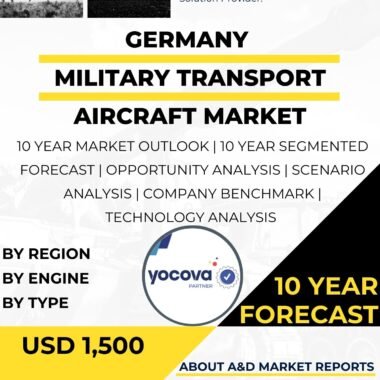Description
The Transport Aircraft market in Malaysia has experienced significant growth and development in recent years, reflecting the country’s commitment to enhancing its air transport capabilities, supporting humanitarian missions, and bolstering its military airlift capabilities. Transport aircraft are versatile aircraft designed to carry passengers, cargo, and equipment over long distances, providing critical airlift capabilities for both civilian and military applications. The adoption of state-of-the-art transport aircraft enables Malaysia to establish a modern and effective air transport system, contributing to the country’s overall connectivity, economic development, and national security.
As a nation with strategic geopolitical importance in Southeast Asia, Malaysia faces diverse challenges, including the need to enhance its air transport infrastructure and support disaster relief operations. The use of transport aircraft allows Malaysia to improve its air mobility and logistical capabilities, enabling rapid response to emergencies and facilitating economic development through improved connectivity.
The Transport Aircraft market in Malaysia has witnessed significant technological advancements. Modern transport aircraft are equipped with advanced avionics, fuel-efficient engines, and cargo handling systems, enabling them to transport passengers and cargo efficiently over long distances. These advancements have expanded the capabilities and operational effectiveness of transport aircraft, making them indispensable assets for civil aviation and military operations.
Moreover, transport aircraft play a pivotal role in supporting various civil aviation requirements in Malaysia. The country’s flagship airline, Malaysia Airlines, operates a fleet of modern transport aircraft to provide domestic and international air travel services. Transport aircraft facilitate passenger travel, cargo transportation, and contribute to Malaysia’s tourism industry and economic growth.
Additionally, the adoption of advanced transport aircraft supports Malaysia’s commitment to enhancing its defense industrial base and fostering indigenous defense capabilities. The Malaysian government has shown interest in developing and manufacturing transport aircraft through local research and development (R&D) initiatives and partnerships with global aerospace companies.
The Malaysian government has recognized the importance of international collaborations in acquiring and developing transport aircraft technologies. Partnerships with leading global aerospace manufacturers have facilitated access to cutting-edge transport aircraft and expertise. These collaborations have enabled technology transfer and capacity building, contributing to the growth of Malaysia’s domestic transport aircraft capabilities.
While the Transport Aircraft market in Malaysia shows promise, it is not without challenges. One of the primary hurdles is the high cost of acquiring and maintaining advanced transport aircraft. These sophisticated airlift platforms require significant investment in research, development, procurement, training, and logistical support. Budget constraints may impact the pace and scale of transport aircraft acquisition and modernization efforts.
Moreover, ensuring skilled pilots, maintenance personnel, and specialized training are essential for maximizing the benefits of transport aircraft. Airlines and military units must invest in continuous training and education to ensure their personnel possess the necessary expertise to operate and maintain transport aircraft safely and efficiently.
Additionally, addressing the evolving air transport requirements and investing in modernization efforts is crucial for effective air mobility and logistical support. The Malaysian government must plan for future air transport needs, including passenger travel demand, cargo transportation, and support for humanitarian and disaster relief missions.
Looking ahead, the Transport Aircraft market in Malaysia is poised for further growth. The government’s commitment to enhancing its air transport capabilities, supporting humanitarian missions, and investing in advanced transport aircraft technologies will drive continued investments in the aviation sector. As transport aircraft technologies continue to evolve and demonstrate their effectiveness, they are likely to play an increasingly pivotal role in Malaysia’s civil aviation and military airlift capabilities.
Moreover, Malaysia’s participation in regional economic initiatives and international humanitarian operations will likely influence its transport aircraft requirements. As the country seeks to strengthen its position as a regional player in air transport and disaster relief, the demand for advanced transport aircraft with versatility and efficiency will increase.
In conclusion, the Transport Aircraft market in Malaysia has experienced significant growth and progress. The government’s focus on enhancing its air transport capabilities, supporting humanitarian missions, and investing in advanced transport aircraft technologies has paved the way for the integration of modern airlift platforms. International collaborations and domestic research efforts have positioned Malaysia as a participant in the global transport aircraft technology landscape.
However, challenges related to budget constraints, technology development, training, air mobility requirements, and engineering expertise must be addressed proactively to sustain and enhance the growth of the Transport Aircraft market in the years to come. By maintaining a modern and effective air transport system, Malaysia can effectively enhance its connectivity, support economic development, and strengthen its overall air mobility and logistical capabilities.




